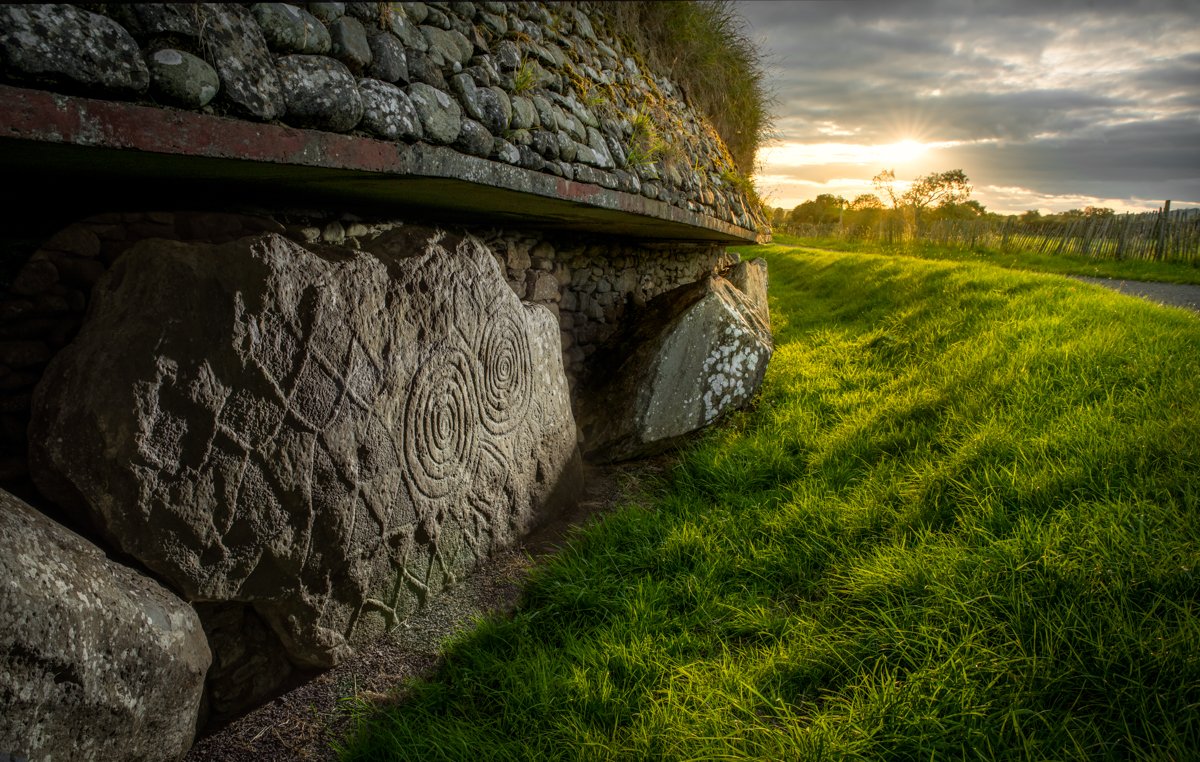
Newgrange: A Second Chamber?
Some first thoughts on the excellent TG4 documentary “Rún na Bóinne” searching for a second chamber at Newgrange
I've just finished watching the excellent documentary on TG4, "Rún na Bóinne" which explored the possibility of a second, hidden chamber within Newgrange. The production was really fantastic, with excellent contributions from several leading specialists of prehistoric Ireland and the scientific team from Slovakia. Here's some of my first, very early, thoughts on the content of the documentary. I will be watching it again to get a better understanding of the interpretations.
The results were of course extremely interesting, with Kerbstone 52, pictured above, featuring heavily. This stone has a line running down the centre which seems to correspond to the vertical lines marking the entrance of Newgrange itself on the opposite side of the mound, and also marking the entrances of both the eastern and western tombs at Knowth. The idea that this line indicated a possible entrance to another, hidden chamber, was explored in the excavations directed by Prof. M.J O'Kelly in the 1960s, and the documentary showed archive photographs and drawings of this excavation. No trace of any passage was found during this work, however.
The results of the new surveys do suggest the possibility of collapsed chambers deep inside the mound, directly behind the known large chamber. There seemed to be at least two large anomalies, but which did not have the zero gravity reading which would have indicated surviving large cavities. Without further invasive excavation it wouldn't be possible to say what the nature of these anomalies are.
It has been known since the excavations in the 1960s and 70s that there was a pre-existing turf mound running from outside the back of Newgrange, under the kerbstones and sloping upwards as it extended inside Newgrange itself. In his excavation reports, Prof. O'Kelly pondered the question of whether this turf mound was a pre-existing monument, perhaps with a chamber, over which Newgrange was later built. This wasn't really mentioned in the documentary, and it would be interesting to see how the micro gravity and ground penetrating radar surveys responded, or not, to this turf mound, or how it might relate to the anomalies found.
It has long been known that an annexe exists off the main northern chamber of Dowth, as shown also in the documentary. This is entered through the right-hand recess of the main chamber and in size it is comparable with the smaller chambers in some of the satellite tombs around Newgrange and Knowth.
Although it wasn't mentioned in the documentary, there is also a small annexe off the main chamber of the smaller passage tomb, known as Site K, just beside Newgrange in the next field to the west. This annexe was very small, probably too small for a person to fit comfortably inside it, but it was clear following excavation by Prof. M.J. O'Kelly that once the main chamber was built, this side annexe was sealed off and couldn't be accessed. This could add weight to the suggestion of inaccessible chambers deep inside the mound of Newgrange.
There is, however, another possibilty which doesn't seem to have been discussed in the documentary itself, but may well be considered when the final reports come to be published. This is the possibility that the anomalies of two collapsed structures may not relate to the passage tomb phase at all, but may instead be the remains of early medieval souterrains. Several of these long, narrow passage structures have been found within the neighboring passage tombs at Knowth and Dowth. The mound of Knowth has several of these, some of which run off from the existing passages, or tunnel in from beneath the kerbstones and also run inside the mound directly from the flat top. The function of these structures is often interpreted as either a safe refuge or for storage. They sometimes are built within early medieval ringforts, showing at least some are from that early medieval period.
All in all, it was a fascinating watch, some very exciting discoveries at a monument that has been studied so closely. The possible socket for a standing stone outside Kerbstone 52 and possibly in line with the summer solstice sunset is very intriguing. Following this up with a small test excavation seems the least invasive way of taking the results further. The documentary also discussed the way the standing stones at Newgrange and Knowth cast shadows on the decorated kerbstones, if a standing stone was indeed placed there, it may well have cast a shadow on Kerbstone 52.
My own recently published research, which documented the first finds of megalithic art on the standing stones outside Newgrange, strongly supports the dating of the placement of these stones to the construction, or use, of the passage tomb.
Congratulations to the producer and director Neal Boyle, who was instrumental in getting the project off the ground, and all the contributors and specialists for their insights into Newgrange and the other, often unsung monuments across Ireland.
The documentary will be available online on the TG4 website, it may be possible to view it right now in the link in the first comment.
Ken Williams - 21st December 2023.
The documentary is now available to watch online here.



